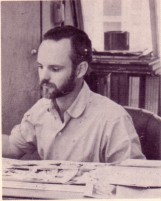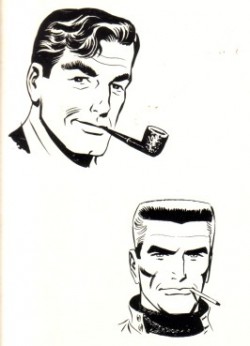Latest Gear Live Videos
Sunday February 21, 2010 2:48 pm
William Overgard: Steve Roper, Mike Nomad, Rudy and Milton Caniff
 William Overgard was a writer, novelist, and comic book artist who had a long-running gig on the Steve Roper (later Steve Roper and Mike Nomad) comic strip. His bold line and storytelling owed a lot to his idol, Milton Caniff.
William Overgard was a writer, novelist, and comic book artist who had a long-running gig on the Steve Roper (later Steve Roper and Mike Nomad) comic strip. His bold line and storytelling owed a lot to his idol, Milton Caniff.
Continuing my little series on cartoonists, here’s what Overgard had to say about his work back in 1964. This is pulled from an oversized saddle-stitched magazine from Allied Publications with the creatively-challenged title These Top Cartoonists Tell How They Create America’s Favorite Comics. It featured an introduction by Beetle Bailey’s Mort Walker and was compiled by Allen Willette. My previous entry on Dennis The Menace’s Fred Toole can be found here.
Here’s Overgard:
 “My formal art training is nil. When I finished high school I went into the Navy, where I did very little drawing for two years. Back home again I went to the Jefferson Machamer School of Art for six months. That was in Santa Monica, California. Then I went to New York where I immediately began to work on comic books.
“My formal art training is nil. When I finished high school I went into the Navy, where I did very little drawing for two years. Back home again I went to the Jefferson Machamer School of Art for six months. That was in Santa Monica, California. Then I went to New York where I immediately began to work on comic books.
“I worked about three years for Biro-Woods, creating a thing called Black Diamond Western. I wrote and drew 30 pages a month. Later, I worked for Dell Comics doing Jungle Jim, Ben Bowie and Steve Canyon. From there I went on to drawing Steve Roper. Steve, of course, had once been a minor character in the strip when it was called Big Chief Wahoo.
“The most important influence on my career has been Milton Caniff. I cannot say enough about this remarkable man. When I was twelve I sent him a fan letter and a crude, little drawing. I received from him an encouraging reply. Thus began a correspondence that gave me the only real training I had in cartooning.
“I am concerned about the current level of adventure comic strips. There are many fine, workman-like examples running in today’s papers, but nothing really fresh or exciting has happened since Terry and the Pirates started the modern school of cartooning. The techniques Milt Caniff perfected have been widely imitated…and sometimes refined. But the adventure strip with all its unique opportunities has bogged down. Perhaps this is because of timidity on the part of some persons, or, more likely, because of a lack of great talent to come up with a bold approach.
“What gives me hope is the renaissance that humor strips have had in recent years. We will just have to wait for another Walt Kelly or Charles Schulz to come along.
“I pencil directly onto a kid-finish board. My penciling is done with a very hard lead (a common #4 pencil), and it’s very roughly and lightly applied.
“Next I outline my figures and backgrounds with a #659 pen. Then I erase the page cleanly and brush in the blacks. I find that this technique gives me a free or loose effect that I always strive to obtain. It also leaves the brushed ink very black.
“I use a great many clippings for background material. I do not use models, either live or photographed. I believe firmly in the ‘cartoon’ approach to adventure strips rather than the ‘illustrated’ style. With the exception of Elmer Woggon, who does the lettering for the strip, I have no assistant. The story, of course, is written by Allen Saunders.”
A couple of things: Doesn’t “kid finish” sound like the name of a boxer from an old Bowery Boys movie?
Elmer Woggon, of course, was the creator of Big Chief Wahoo. It’s weird to me that by the time this was written, he was just lettering a strip he created.
Allen Saunders wrote not just Big Chief Wahoo and Steve Roper, but also wrote Mary Worth and Kerry Drake. His autobiography was serialized in various issues of Rick Marschall’s NEMO magazine.
William Overgard also created, wrote and illustrated the great, though short-lived, 1980s-era comic strip, Rudy.
Mike Sterling over at Progressive Ruin has a nice appreciation of Rudy.
Syracuse University has a nice collection of Overgard’s work, from 1954-1968.
John Glenn Taylor at Easily Mused posts a really nifty “Crisco Keed” parody story by Overgard that originally appeared in The Three Stooges #7 in 1954, the same year Overgard took over Steve Roper.
The New York Times (no firewall, yet) has Overgard’s brief obituary.
Terry Beatty posted an Overgard Zane Grey story over at his blog.
[Artwork: photo of William Overgard, circa 1964 (top) and Steve Roper and Mike Nomad (bottom)]
- Related Tags:
- allen saunders, allen willette, big chief wahoo, biro-woods, black diamond western, cartooning, cartoonist, charles schulz, elmer woggon, jefferson machamer, milton caniff, mort walker, rudy, sidefeatured, steve roper and mike nomad, terry and the pirates, the three stooges, walt kelly, william overgard
Advertisement
Advertisement
Advertisement
© Gear Live Media, LLC. 2007 – User-posted content, unless source is quoted, is licensed under a Creative Commons Public Domain License. Gear Live graphics, logos, designs, page headers, button icons, videos, articles, blogs, forums, scripts and other service names are the trademarks of Gear Live Inc.












Comments: